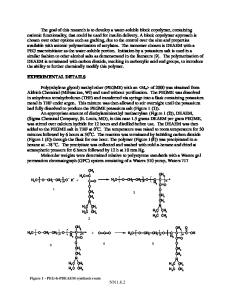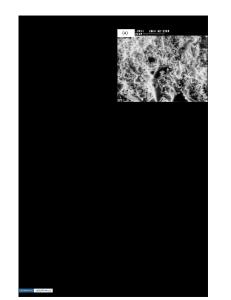Synthesis and characterization of donor-acceptor perylene based copolymers
- PDF / 228,611 Bytes
- 6 Pages / 612 x 792 pts (letter) Page_size
- 56 Downloads / 317 Views
1212-S08-08
Synthesis and characterization of donor-acceptor perylene based copolymers Erika Kozma, Filomena Munno, Dariusz Kotowski, Fabio Bertini, Silvia Luzzati, Marinella Catellani Istituto per lo Studio delle Macromolecole – CNR, via Bassini 15, 20133 Milano, Italy ABSTRACT Two donor-acceptor copolymers containing perylene diimide and oligothiophenes linked through triple bonds have been designed and synthesized by palladium catalyzed Sonogashira coupling reaction. The introduction of the triple bond spacer between the electron-acceptor perylene moieties and the electron donating oligothiophene moieties produces an extended conjugation along the main chain, and produces soluble and high molecular weight copolymers. The thermal, optical and electrochemical properties of these copolymers were examined. The HOMO-LUMO energy levels of these copolymers, along with the photoinduced charge transfer process, probed by photoluminescence quenching and by FTIR photoinduced absorption spectroscopy, in blends with poly(3-hexylthiophene) (P3HT), indicate that they are suitable materials for application as electron acceptor and n-type components in bulk heterojunction solar cells with P3HT. INTRODUCTION Conjugated polymers have continuously received intense attention due to their unique optical and electrical properties and have become important materials for the fabrication of low cost and large area flexible optoelectronic devices, such as solar cells [1]. For these type of applications, the electron-donating or electron accepting properties of the conjugated polymer are of crucial importance. Considerable efforts have been put into the design and synthesis of various donoracceptor architectures, because the intramolecular energy transfer and charge separation of πconjugated systems with donor-acceptor properties can mimic the photochemical and photophysical processes that take place in the natural photosynthetic reactions [2]. During the last few years, several groups focused their attention on perylene diimide (PDI) dyes, which act as electron-acceptors and exhibit high thermal and photochemical stability, strong absorption of the visible light, with relatively high electron affinity and good electron transport properties. These outstanding properties have rendered them promising building blocks for donor-acceptor type small molecules [3] or polymers, by functionalizing the perylene core along the imide positions [4] or in bay positions [5]. However, previous structure calculations have revealed that nods exists in the imide nitrogen atoms, which is unfavourable for the efficient electronic interaction between the PDI and the unit which is linked at the nitrogen atom position [6]. Therefore, the substitution in the bay region of the perylene core through different coupling reaction became an interesting alternative to favour the electronic communication between the donor and acceptor moieties. On the other hand, it is already well know that oligothiophene are electron donating moieties and there are chemically versatile
Data Loading...











